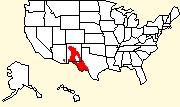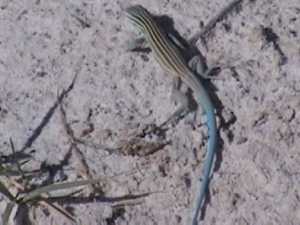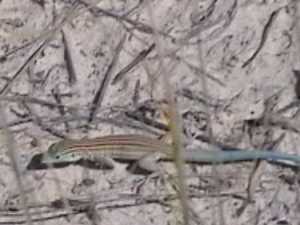|
Trans-Pecos Little Striped Whiptail
|
- Order: Squamata (scaled reptiles)
- Suborder: Lacertilia (=Sauria) (lizards)
- Family: Teiidae (ameivas and whiptails)
- Genus: Cnemidophorus (whiptails)
|
|
Scientific Name: Cnemidophorus
inornatus heptagrammus Axtell, 1961 |
| Habitat: Arid regions
with scattered ground cover. |
Knemidos="greaves" (armor), phoros="wearing"
(referring to large scales on the arms), inornatus="without
ornamentation," hepta="seven," gramme="marks
(stripes)"
|
| Length: Up to 9.5 inches
(most of which is tail). |
|
| Food: Insects and
arachnids. |
 |
|
These pictures are stills from my video camera,
and are a little blurry because this lizard was constantly
moving. Whiptails are known for their jerky movements as
they dart about looking for food. They can run extremely
fast if threatened, but usually if you remain still they will
resume their normal activity and are amusing to watch. |
 |
| Whiptails are fairly common and
easy to find, but not easy to catch! They are among the fastest
lizards in the world. While exploring and searching for food, they
exhibit a characteristic jerking motion as they move which is
amusing to watch. There are 16 species of whiptail in the United
States, and they can be difficult to identify without careful
inspection of scale patterns. An interesting note: several species
are parthenogenetic, which means they are all female and reproduce
without mating. |
 |
|
|
|
|
|
|
|